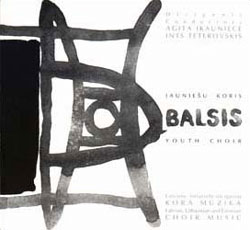
Now that the World Wide Web has made it possible for independent musicians and ensembles to internationally promote and sell their music and recordings more easily and effectively, any new release has a great deal of competition for potential buyers’ attention. As Latvian music becomes more recognized and popular on an increasingly crowded world stage, effective presentation of its heritage and artistry is vital in reaching out to listeners.
A recent album from the Latvian youth choir Balsis is musically excellent and well-recorded, but despite its professional appearance and attractive packaging, I wonder if the producers were not entirely certain of their intended audience, or perhaps the idea of marketing to other than Latvian buyers was an afterthought?
Formed in 1987, Balsis have garnered numerous prizes at choral competitions. Their current directors, Agita Ikauniece and Ints Teterovskis, are highly skilled choral professionals who have successfully maintained a high standard in their group’s level of performance, vocal technique and skill. The 40 singers produce a clean, supple sound and the youthfulness of their voices is not excessively shaded to produce an artificially mature sound. Perhaps due to the recording, the sopranos seem a little harsh in louder passages, but elsewhere the group maintains a pleasing blend.
The program is a varied one: 14 Latvian composers from several generations represented by 10 original compositions and six folksong arrangements, and three Estonians and a Lithuanian for good measure.
Some works are very familiar or widely recorded, such as Jānis Cimze’s arrangement of “Raven in the Oak Tree,” Lūcija Garūta’s version of the “Lord’s Prayer,” and Estonian Arvo Part’s setting of the Latin “Magnificat.” Works of several younger composers comprise a substantial portion of the program: Latvian-American Anita Kuprisa’s arrangement of “Sun, Attire Yourself in Silver” has become a Latvian classic on both sides of the Atlantic (with some added vocal effects in this version), and Jānis Lūsēns’ “Latvian Lullaby” is surely destined to become one as well. Other works are less frequently encountered. I was especially taken with Jāzeps Mediņš’ rarely-heard “Summer Evening” and Lithuanian Vytautas Barkauskas’ dazzlingly virtuosic “Kommedia dell arte.”
While there is obvious structure in the ordering of the music (original Latvian compositions followed by other Baltic composers’ works and concluding with folksong arrangements), a lack of contrast in mood during the first half of the program creates an overall effect that could be characterized by some as contemplative and by others as soporific. On the other hand, the concluding folksongs are generally more upbeat and vigorous. More overall variety in the pacing of the program would have been welcome.
Some introduction to the composers would have been helpful in the booklet, too, especially when the bilingual packaging makes this disc more than a commemorative souvenir for a limited audience. Perhaps as an afterthought or supplement, there is a more extended general commentary on the group and this album on the choir’s well-designed Web site, though the English version could be more idiomatic. I also wonder which conductor conducts which piece? Neither the album nor the Web site offers any clue.
More annoying is the listing of composers’ first names with only an initial or abbreviation, and the lack of birthdates for folksong arrangers. Composers deserve to have their full names listed, and respected musicians whose shaping and enhancement of folk melodies and texts is often equivalent to the creation of entirely new compositions shouldn’t be looked upon as second-class musical citizens. There is no good reason for perpetuating such Soviet-era practices, familiar to collectors of old Melodiya LPs.
This is a well-sung, sensitively interpreted program of fine music and these criticisms are not intended as a condemnation of the album—I have no hesitation in recommending it on musical grounds. But skimpy or incomplete information can lead to a lost opportunity to cultivate listeners who might otherwise be enticed into further exploration of Latvian music. Sometimes we Latvians can be our own worst enemies in the way we present ourselves and our artistry to the world at large, which is much more eager and willing to honor and embrace us than we may suspect.
Details
Latviešu, lietuviešu un igauņu kora mūzika
Jauniešu koris Balsis
AIIT, 1999
© 1995-2024 Latvians Online
Please contact us for editorial queries, or for permission to republish material. Disclaimer: The content of Web sites to which Latvians Online provides links does not necessarily reflect the opinion of Latvians Online, its staff or its sponsors.




